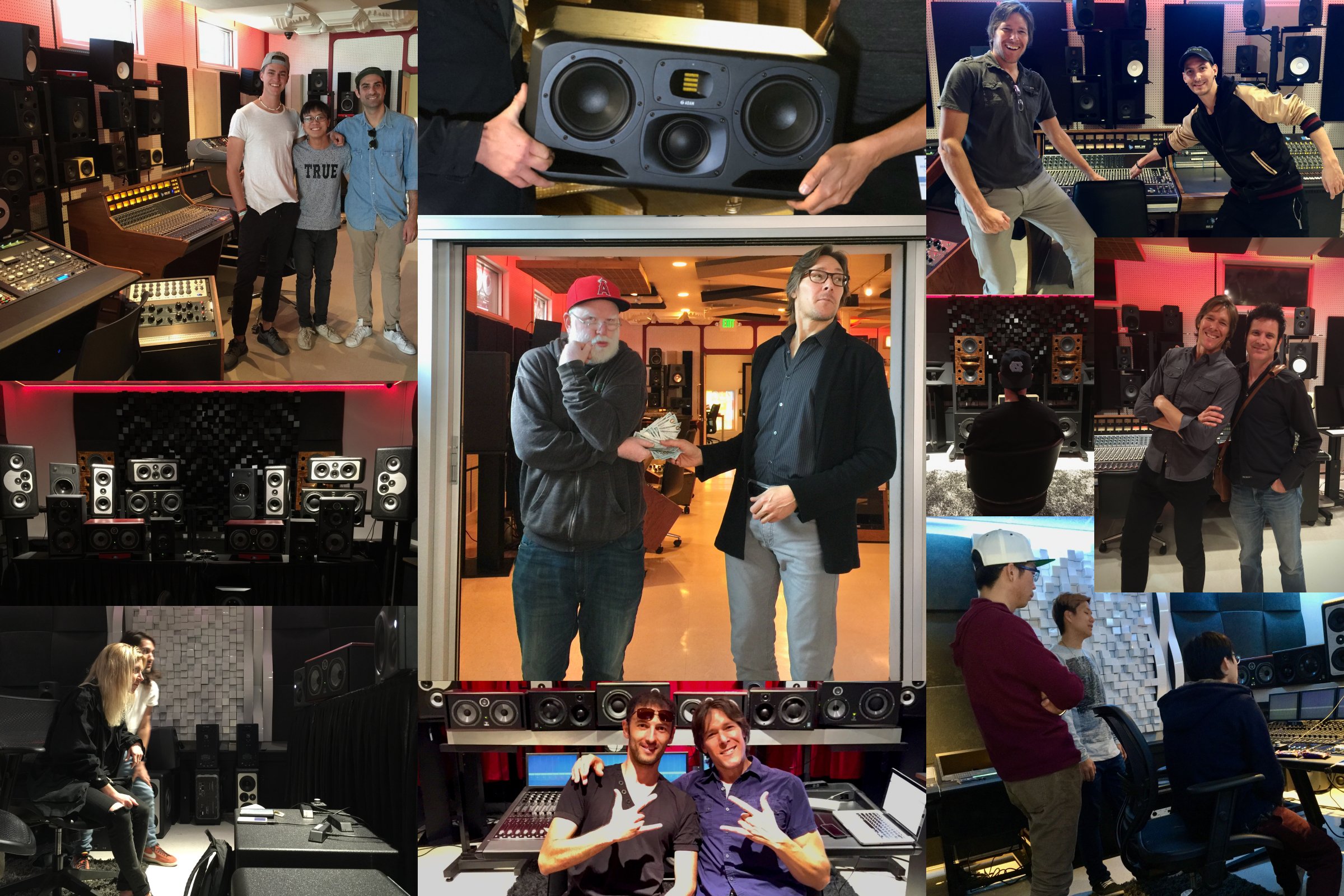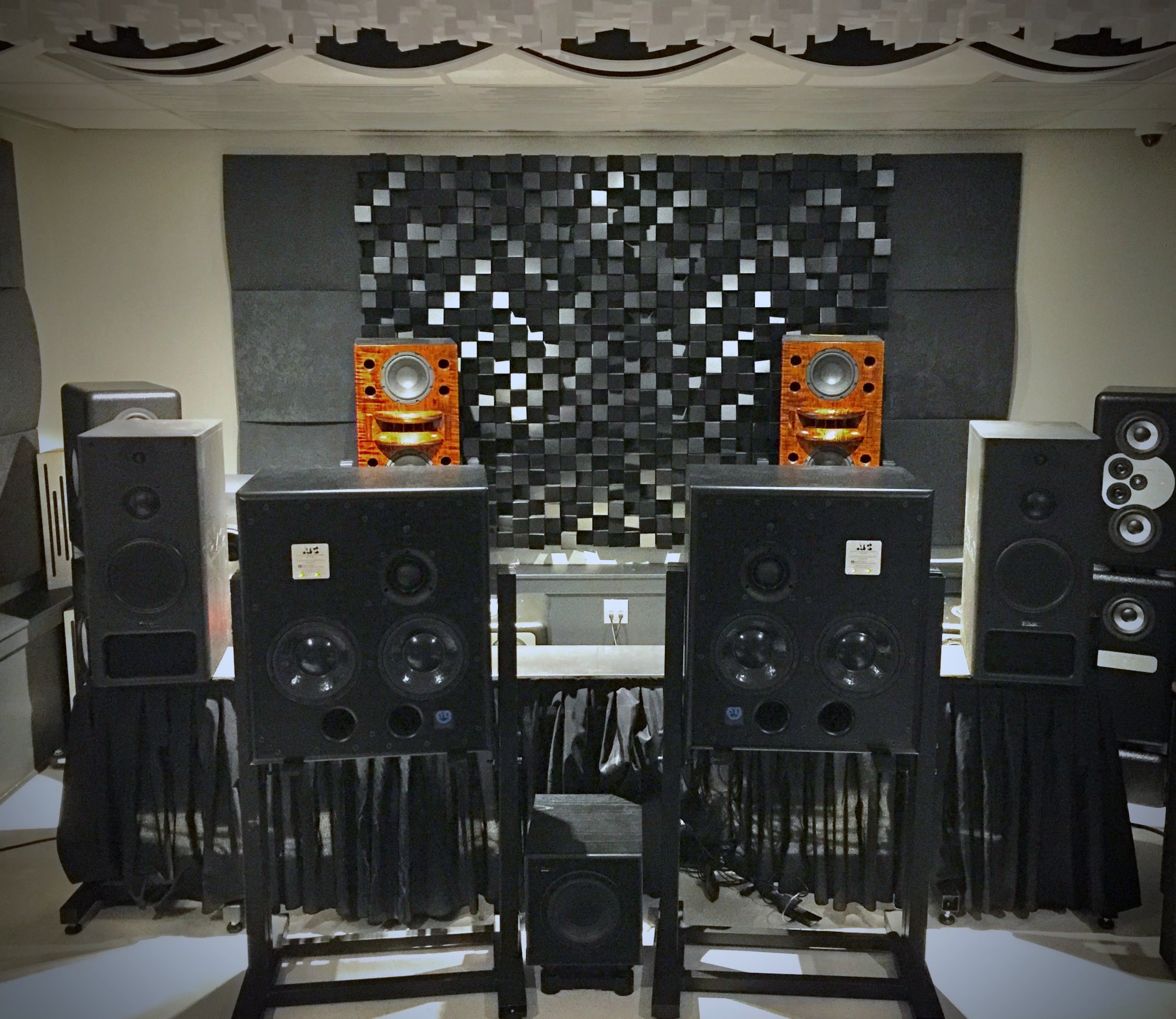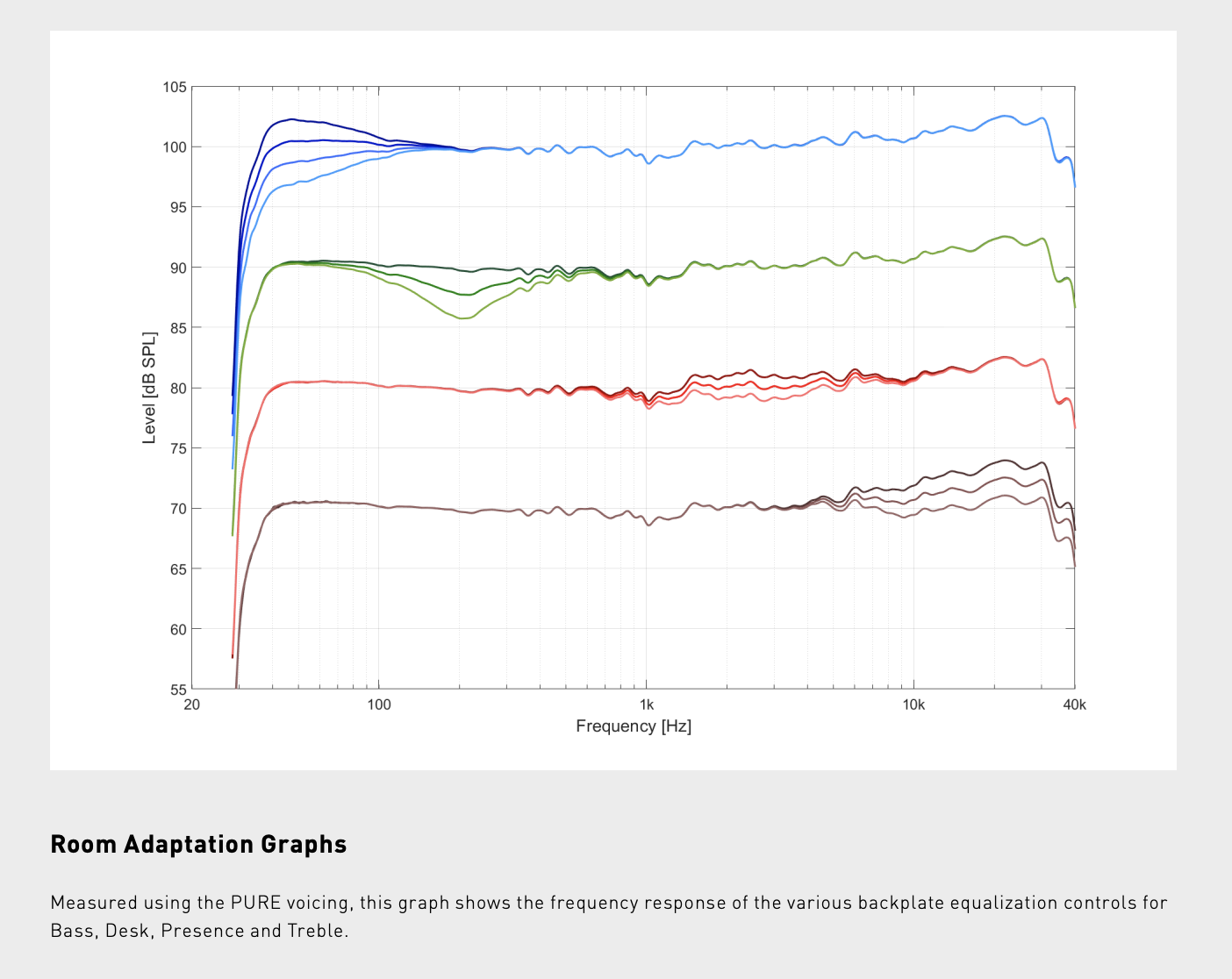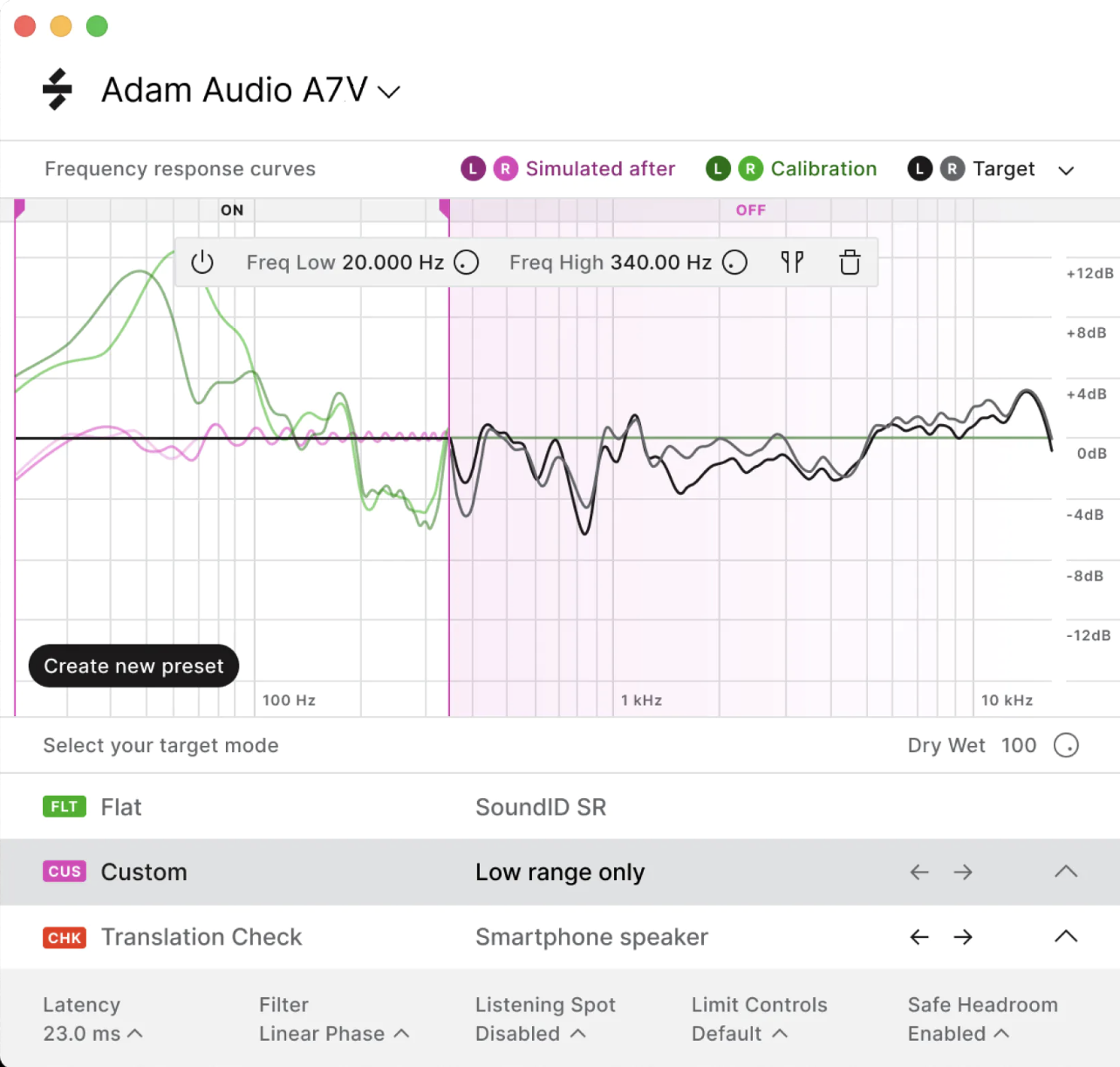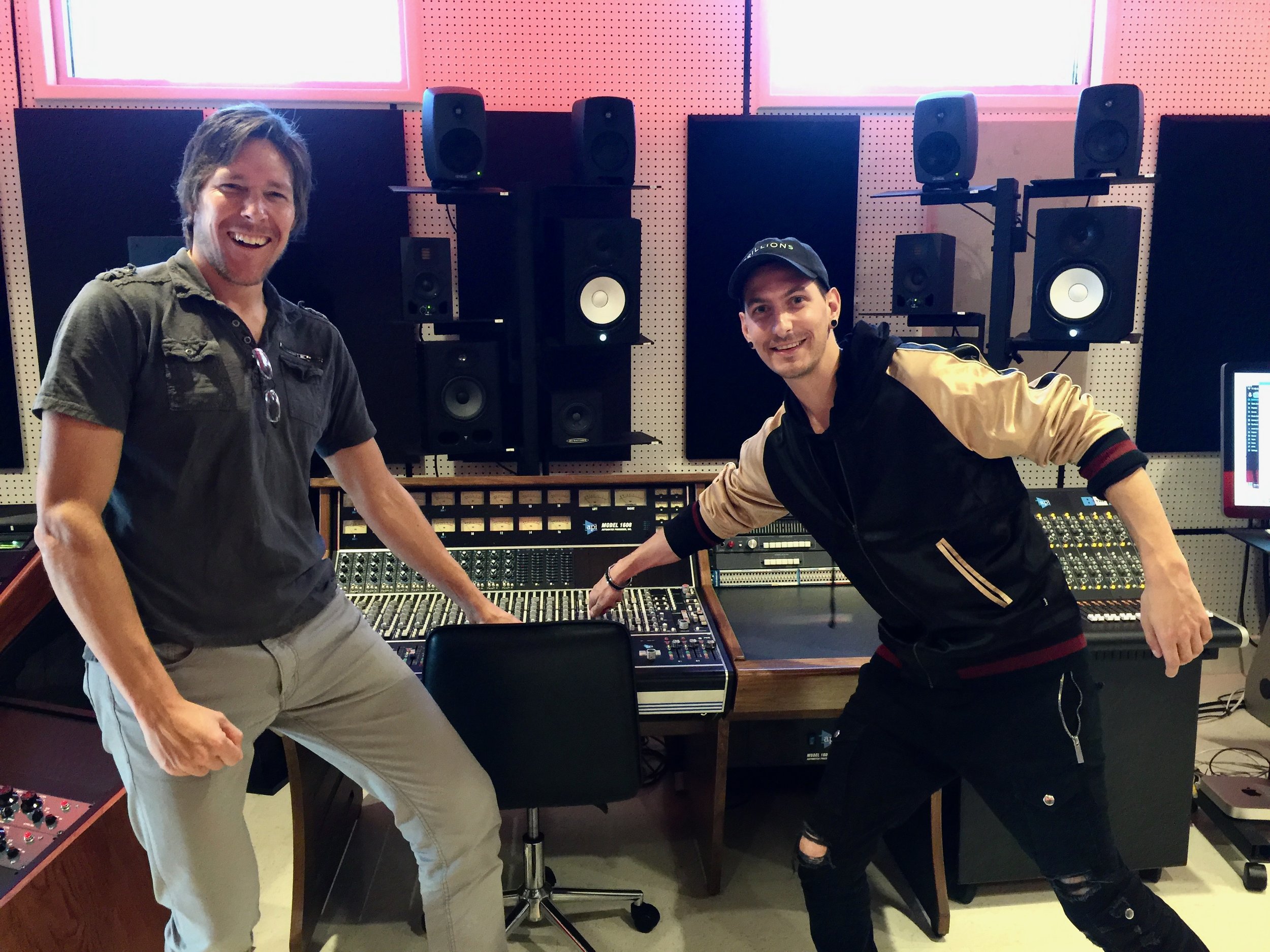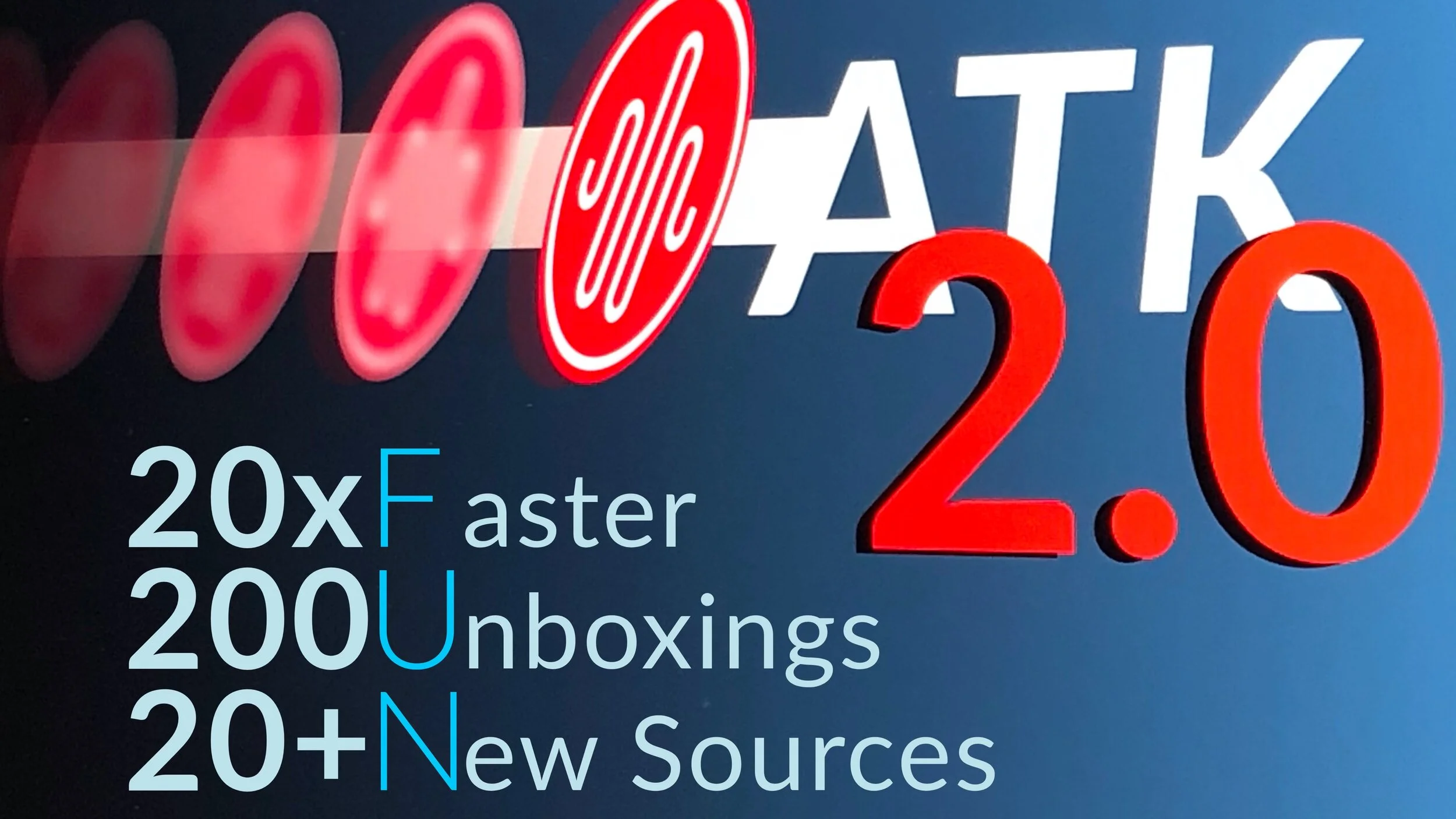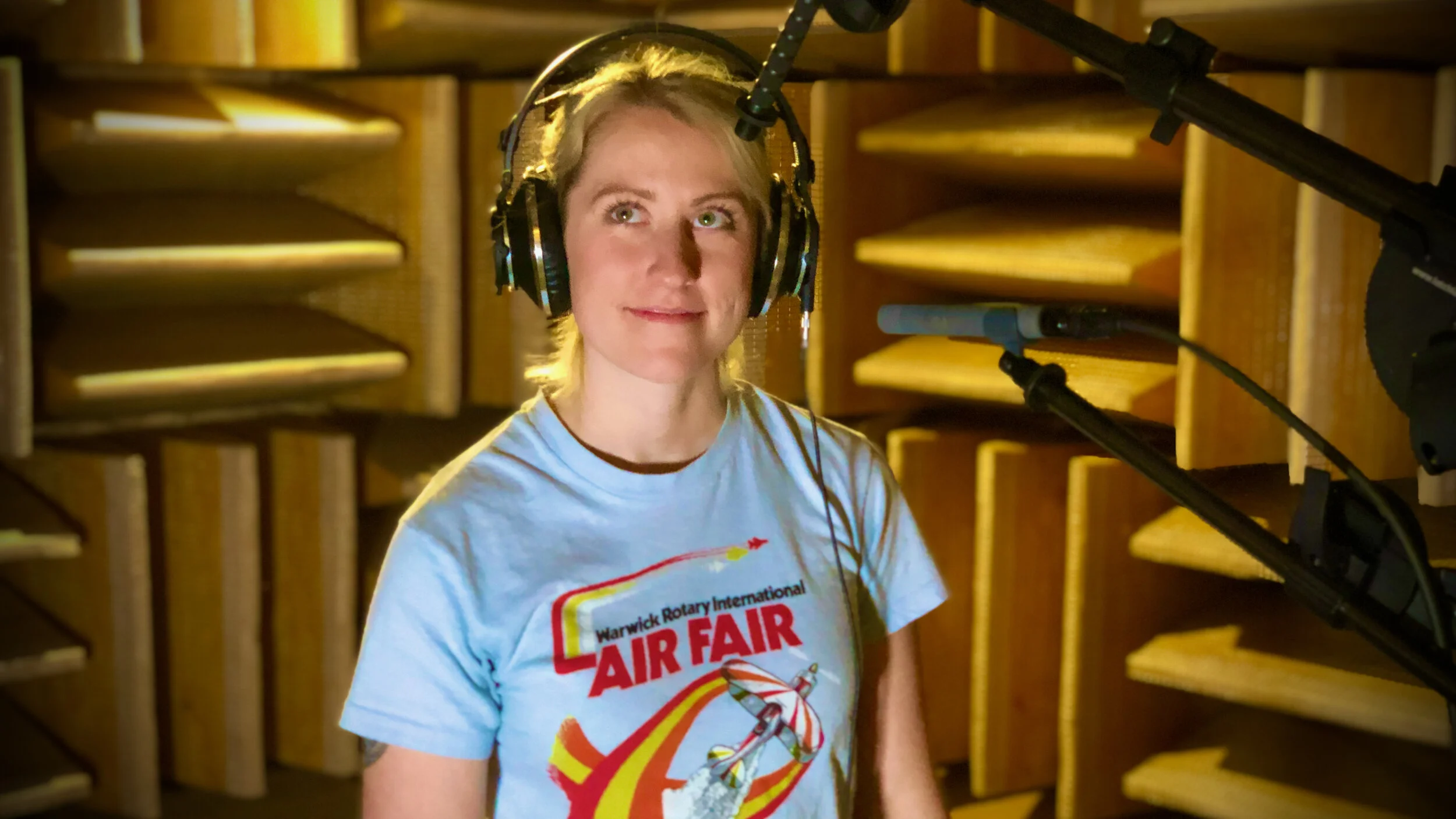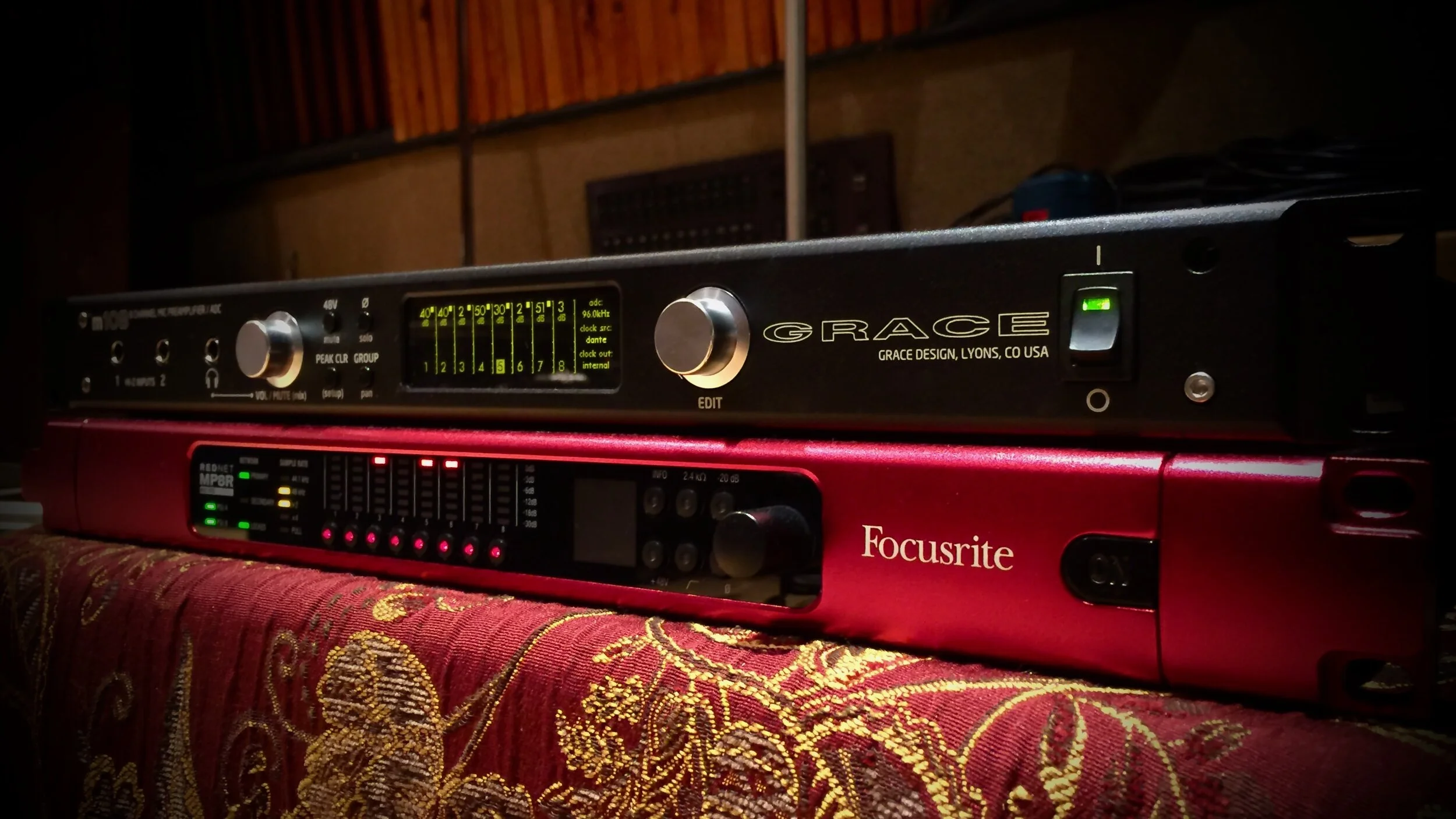How To Choose Studio Monitors - A Former Salesperson's Guide
Scenes from a professional studio monitor showroom in Los Angeles, back when Audio Test Kitchen founder Alex Oana was a salesperson.
Culver City, California
PART 1 - A FORMER SALESPERSON’S PERSPECTIVE, PLUS
For audio creators the studio monitor is the lens through which we hear our world. Our studio monitors determine how deeply and faithfully we can access the sound and therefore every choice we make. Studio monitoring is more than speakers. It incorporates loudspeaker design and acoustics – massive topics filling books. But I offer you a unique perspective: I used to help people shop for studio monitors at one of the world’s only high-end pro audio showrooms. Of course I’ve relied on monitors throughout my career as a recording engineer. And now Audio Test Kitchen is developing our own speakers for testing microphones. And all this has its origins in the weekends I spent as a teenager obsessively listening to speakers at the local Hi Fi shops with my best friend Russ. Speakers are some of my favorite things. They are a rare device that converts one form of energy into another, and that’s thrilling.
So while there’s no single answer to “What is the best studio monitor?” I can offer a thought process and give you enough big picture take-aways and enough technical background that you’ll be better equipped to navigate your journey to choose studio monitors and get the most out of them.
CREATIVITY MATTERS MOST
No great record was ever stopped from being great by the equipment. It is possible to ‘get to know’ any monitor you’re working on and room you’re working in as long as you’re able to reference that work on other speaker and headphone systems which, all together, reveal what your work really sounds like. The ideal monitor minimizes this translation process, doesn’t lead you to misguided decisions, is pleasant or non-fatiguing to listen to, and facilitates spontaneous creativity as well as precise scrutiny. The way any monitor and room translates to the rest of the world must be ‘learned’ to some extent.
Ideally we find a monitor we can afford that minimizes the bad and maximizes the good.
Shawn Taylor and Alex Oana became good friends through their work together as client & salesperson
TAKE IT FROM A FORMER SALESPERSON
I used to sell pro audio gear for a boutique retailer. It was best when shoppers were able to come into the showroom in Los Angeles to listen for themselves. But folks who couldn’t make it into the showroom had two big disadvantages: They couldn’t choose for themselves, based on their own preferences, and they had to rely on other opinions, like mine, biased by my preferences and experience.
Beyond any other type of research or advice, the thing you get with a first-hand listening experience is the vibe of each speaker. Just like everyone’s ears are different, so are the voicings of each speaker. This ‘voice’ is made up of a combination of a monitor’s EQ curve, resonances, the character of the materials, the way the sound combines. Until Audio Test Kitchen makes it possible for you to audition studio monitors online, we need to navigate the chaos the old fashioned way.
ACOUSTICS CAVEAT
Your room affects everything you hear from your speakers. They are a system. In an upcoming episode of this blog on how to choose studio monitors, we’ll hear from an acoustician. Let’s start with the monitors.
Until Audio Test Kitchen makes it possible to audition studio monitors online, listening to studio monitors is the best way to choose.
LISTEN TO THE PRODUCT
When it comes to helping music gear shoppers efficiently find the best product fit, again and again I return to the need to listen to the product first hand. When choosing studio monitors, listen in person if you can. Order several monitors from retailers that will let you return them. Keep all the packaging in pristine condition and handle the monitors in a way that leaves them as you would want to receive them if you were buying an open-box or demo item. It’s the right and cool thing to do.
LEARN BY PROXY?
The equipment is one part of the sonic result, but the way we hear and how we interpret what we hear is the biggest factor. Put me in the same studio to mix the same tracks as another engineer and I will not make the same record even if I tried. Yet it can be useful to try to hear, work, and learn through the same lenses as someone whose work inspires you.
Have any favorite sounding recordings? Find out who mixed them and find out what monitors they use. If you can’t afford the monitors they use, DM the person who mixed the recording and ask if they’ll share some guidance or recommendations - perhaps they know of a more affordable product you can start with. Keep in mind, their room sounds different from yours. And try to determine whether they are a paid endorsee. In the pro audio world, when it comes to endorsements, typically the engineer/producer/mixer first chooses their favorite gear, then figures out how to get some kind of a deal on the price in exchange for permitting the company to publicize their use of it. It’s not a payola situation.
My sense is that in the YouTube/influencer world, the paid promotion model is dominant. In other words, the reason those products appear in their content is not likely to be based firstly on product performance. I wouldn’t automatically consider a YouTuber or influencer’s use of a product as an indicator of well-deliberated, scrutinized research. But with less sophistication and deliberation can come liberation for those who prioritize the content over tools to make it. Sometimes that’s the top priority.
Some studio monitors like the ADAM Audio A Series now offer software control of room compensation and custom EQ parameters.
TECHNOLOGY THAT ADAPTS
Consider monitors with built-in flexibility. Monitors are built to sound ‘right’ in a neutral environment that probably doesn’t represent the room where you’ll be working. And what if you change rooms or studios? DSP-based monitors often have the ability to adapt to different spaces and even listening preferences. Many monitors offer placement compensation EQ settings and even basic high and low contour controls.
In 1997 when Mackie released HR824 to compete with the Genelec 1031A (considered the grandfather of active studio monitors), we were introduced to settings on the back of the monitor that could compensate for various room conditions as well as subtly shape the bass and treble. I owned these speakers. The compensation settings worked. Now these features are fairly common and found in approachable products from brands like Kali Audio, Yamaha, JBL, and KRK.
CONSIDER BUT DON’T SOLELY CHOOSE ON PRICE
What do you get when you spend more? Does performance always correlate with price? Let’s look at it from the manufacturer’s perspective. Higher product prices don’t necessarily mean the manufacturer is getting richer, but it does usually mean they need to or have more available to spend on:
Labor
Parts
Finishes
Support
Packaging
Marketing
Proprietary parts
Costs associated with the economy where their business is based
If you can determine these aspects about the manufacturer, you can better frame what might have gone into the product and choose based on which aspects are important to you.
Price doesn’t always directly correlate with performance. You’d be amazed at how many multi hundred dollar speakers use tweeters that cost $3. Better quality parts generally produce fewer artifacts like distortion. Higher priced studio monitors have a better chance of undergoing more strict quality control to ensure better consistency between sets, producing better imagining and precision in multi-channel, immersive setups. It’s more and more common that US and European based manufacturers produce parts at a lower cost in Asia then do quality control, assembly, testing, and shipping from their Western headquarters.
There are notable exceptions in every price range where the performance delivers beyond expectation at the price. Often a loudspeaker manufacturer trickles down their top-of-the-line tech into their more affordable products.
WHERE AND HOW IS IT MADE
Most affordable monitors are made in China which in itself is not an issue. Because Chinese manufacturers are typically pressured to produce at the lowest possible prices they are often forced to cut as many corners as possible, resulting in compromises in consistency and robustness. Smart brands who produce in China perform independent quality control of parts and the final product before they ship to consumers.
Higher priced monitors that have features similar to more affordable options could be more expensive because they’re built by hand or are developed in countries with higher labor prices. Some of the most revered music products are built by hand, from acoustic guitars to guitar amps, microphones and their capsules, ribbon mics, ribbon tweeters, drum shells, electric guitars, violins, etc. There’s something extra special about a product that individual craftspeople poured their attention and care into that also performs a beautiful function like making music, and you’ll pay for that experience.
INDUSTRY STANDARDS VS CHALLENGERS
This consideration is particularly tricky. Some products have become industry standards because they truly facilitate great results in a wide variety of scenarios. But beware the herd mentality. Sometimes industry standard products just do a particular “thing” that primarily offers a reliable path to a specific result or experience. Sometimes the reasoning is, “Why change a good thing?” But sometimes it’s complacency and lack of innovation. Challengers in the market often present greater value and flexibility per dollar, but can struggle to prove it among all the noise and competing products. Some challengers’ copycat products draft entirely off other products’ hard-won success. If you want a specific result or function, buy the original or look for a well-regarded ‘tribute’ or clone. If you want more innovation, look for the challengers and brands that refresh their technology. Product designers and engineers are constantly striving for perfection, but because they can only try a limited number of ideas per product cycle, there’s usually a backlog of great ideas queued up for the next product refresh. But just because something is new does not mean it’s better or will transform your abilities and results. Because each product highlights sound differently, when we do get a new reference point, we inherently listen differently, perhaps more intently. This is a strong argument for having multiple sets of monitors to keep your perspective fresh as you work.
INNOVATION
Newcomer monitor manufacturers in the market can start with the advantage of applying the industry’s last 100 years of learnings right from the beginning. These companies can circumvent expensive trial and error and launch highly refined products at a lower cost. Companies that have been around longer can still innovate. Make sure new versions of established products offer more than cosmetic improvements. Look for new technologies such as integrated DSP, changes to driver materials, and amplifier updates.
FLAT VS FUN
This question I got from friend and synthwave recording artist Andrew Benon brings up an important consideration:
“With monitors, I worry that the contours I like in my recreational listening (a sub you can feel, a scooped mid range) are not what I should be looking for in perfectly flat studio monitors. I have no compass on what flat even sounds like. Maybe I don’t even like the sound of flat. Do I? Should I?”
Andrew, it’s totally OK to want to both trust and enjoy your studio monitors. These features ideally are not mutually exclusive within a single studio monitor, and certainly can exist separately across multiple monitors in your studio. But an accurate studio monitor may reveal that some of our favorite recordings don’t sound good. The music may be great, but the sound kinda sucks. Pure listening pleasure is what Sonos is for. And I always check my mixes on my various Sonos systems. I recommend having another set of reference speakers for listening pleasure. These could be studio monitors, a smart speaker, or whatever you like.
It’s true that some studio monitors are designed to produce an exaggerated, hyped sound, often with EQ boosts in the bass and treble. Lower quality speakers might even sound more full because of the harmonic distortion in the bass that occurs due to driver distortion and other resonances. Such a speaker might even win in a superficial shootout. If this is what we’re used to, it can be shocking to hear audio for the first time on a very clean, undistorted system. It might at first not sound as impressive or engaging, but it’s what’s really there. That’s what I experienced the first time I heard a set of high end studio monitors – it sounded like there wasn’t any bass. Just turns out I was hearing true bass for the first time.
Accuracy is most important in a studio monitor, but the moment you put a speaker in a room, there’s no such thing as flat.
To me, the ideal studio monitor enables us to
Enjoy listening to our favorite recordings that we know to sound
Analyze the sonic DNA of our favorite music
Work effortlessly and enjoyably
Make decisions that translate accurately to the rest of the world
And it’s totally fine to tune your system with a bass and treble boost if that’s the way you like hearing audio. This very feature is making its way into more studio monitors are switchable sound profiles or response curves. Sometimes this is enabled digitally through DSP, sometimes traditional EQ filters. For example, ADAM Audio’s DSP-driven A Series and S Series monitors offer settings both for flat, accurate response and ‘listening pleasure’ modes. Tools like Trinnov and Sonarworks take this to another level, enabling EQ compensations customized to your room via a measurement microphone and software tweaking. ADAM Audio’s A Series is also one of a few monitors to incorporate Sonarworks.
3-WAY SYSTEMS
Another major signpost in monitoring quality that often comes at higher prices is the three-way design. There can be advantages to optimizing individual drivers for bass, midrange, and treble compared with covering all the frequencies with a single full range or two-way (woofer+tweeter) arrangement. More parts + more complexity = higher cost.
An average size home studio.
ROOM SIZE VS. SOUND LEVEL
How loud the speakers sound in your room is determined by three things: the speaker’s output capability, the size of the room, and how far away you’re listening. Speakers move air. Small room, less air. Large room, more air to move to play at the same volume. You can move more air with more power. Power comes from the amplifiers, the drivers’ (woofer, tweeter) output capability, and the speaker enclosure’s effectiveness at transmitting that power into the room, as opposed to losing the energy to cabinet vibration, for example.
Just by their size, we might assume larger monitors have more headroom, can play louder, and fill a larger room. This will be true if the amplifier power and cabinet efficiency also have increased capabilities.
There’s a spec called ‘Maximum SPL’ (Sound Pressure Level) that is designed to help you compare their volume capability. The problem is the spec is inherently misleading and it’s measured differently by different brands. The two biggest unknowns with this spec are the extent to which it tells us how loud a speaker can play at the lowest frequencies, and whether they’re talking about a quick volume peak or a sustained loud volume. It’s really common that studio monitors can play much louder in the midrange than in the bass. The SPL specs likely don’t tell the whole story of how loud a monitor can go.
Almost none of the manufacturers make this information easy to find. Until someone like Audio Test Kitchen measures all studio monitors under the same conditions and makes the measurements easy to translate into useful information like how loud the speaker will sound in your room, we’re stuck with what we’ve got.
So for now, let’s conclude that larger monitors, with larger drivers, more powerful amplifiers are strong indicators of potentially higher output. Unless we dive into distortion specs, we don’t know how clean, pleasant, accurate, or distorted that sound will be, but it’s a start.
GORGEOUS SPECS
Let’s say for example we want to compare two monitors that look the same on the face of it. They’re both 8”, two-way, 150 watt bi-amped, monitors in 14” cabinets with a front port, but one is $399 and the other is $999. We have a problem because we know that we can’t read specs at face value and because every manufacturer measures differently. It’s hard or irrelevant to compare them. In the world we currently live in, we’d have to either use the guidance I shared for correlating price with performance, search around for anecdotal evidence, find someone who has compared them, or ask a salesperson.
What’s needed is one standard for taking measurements, a companion tool for visually comparing the data, along with guidance that makes it easy to understand how those measurements will affect your results at the end of the day. Someone please give me my own anechoic chamber!
I’m going to geek out on specs here for a second. The one manufacturer I’m aware of that does a thorough job of publishing all the important specs is ADAM Audio. There may be others who do this, but I haven’t seen them. Check out ADAM Audio’s measurement data for the popular A7V, for example. It’s a treasure trove of speaker performance information. It’s not possible to do an ATK-style overlay of the measurements between speaker models, but the data is there and it’s incredible. For example, I can see where the smaller A4V rolls off in the bass, giving me an idea of whether I would want to pair it with a sub. Looking at the A8H, beyond seeing that it’s flat to 40Hz, when I look at the distortion graphs I can see the quality of those frequencies.
PMC publishes good written specs and a useful speaker directivity graph. What’s really fascinating to see is PMC’s behind the scenes R&D process. To me, that kind of transparency increases my trust in a brand’s products.
SUB
In a stereo monitoring rig, subwoofers should be considered for two reasons: to extend the response of the L&R mains, and to expand the headroom of the overall system.
In the first scenario, the main speakers you’re considering or already own may have limited coverage down into the lowest frequencies. In the second scenario you either need/want more low frequency power so you can bump that sh*t, or you want to increase the headroom on your L&R mains by reducing their workload in the lowest, most power-hungry frequencies. A sub may enable you to turn up the system louder, or fill a larger room.
It’s not required, but it can be beneficial to buy a sub of the same brand/family as your L&R mains because the designers have undoubtedly designed the crossover to integrate seamlessly within their family of products.
Again, it would be great if we had reliable information to determine exactly how low a speaker can effectively play and a standard to compare across products and brands.
TRUSTWORTHY SOURCES
We’ve determined in the world’s current state, we will likely need to seek recommendations to help inform our decisions. Think about what the recommender stands to gain by helping you. Here’s some transparency for you: Audio Test Kitchen was paid by ADAM Audio to write this blog as a companion to us spreading the word about ADAM’s new A Series in our newsletter. ADAM has no editorial control over what I write in this blog, but I’m aware of how social reciprocity influences me as I write. I find myself framing portions of this discussion in ways that support ADAM’s logic for their product series refresh. I’ve chosen to discuss features and philosophies that are elements of the A Series’ value proposition. To be fair, these are not qualities or features exclusive to ADAM’s A Series, although it’s notable they are one of the first manufacturers to integrate Sonarworks. In any light, ADAM Audio’s publishing of detailed performance data is to be commended and aspired to. Having created the world’s first totally unbiased audio product comparison platform, I hope you can see my commitment to empowering you to make your own unbiased choice.
ADAM S3H with Schoeps CMC6 MK2 in one of Harman’s anechoic chambers during Audio Test Kitchen’s research and development
More transparency: ADAM’s S3H monitor solved a huge problem for us in producing microphone comparison content. Through our R&D process we auditioned many different monitors to serve as our vocal reproducer for reamplifying single vocal performances into hundreds of microphones. The ADAM S3H was chosen because what we heard back through the microphones in front of it sounded the most like the original vocals we put into it. Perhaps this is due to ADAM’s folded ribbon tweeter. The sound we recorded from them in the anechoic chamber also measured the closest to the sound we put into them. We also chose the ATC SCM45A for reamplifying some of our vocal content. We were not paid to use either of these, rather we were fortunate to receive the enthusiastic support of the manufacturers reps from each company. Thank you again, ADAM and ATC.
A trustworthy salesperson is invested in their client’s long term success, not just a quick sale.
WHAT THE SALESPERSON IS THINKING
I sold pro audio gear for one of the top US retailers in person at their Los Angeles showroom and over the phone and email for four years. They hired me to advise their customers because of all the records I had made using both vintage and modern equipment, and for my long list of contacts. For me it was an honor to be in the position of guiding and recommending a fellow audio creator’s gear selection. As a recording engineer I strongly associate equipment with the vision I want to achieve. The gear is my brushes and paints. I also believe I can make a great sounding recording or mix a show with just about anything. When it comes to advising and recommending equipment to my friends and clients, I felt and still feel an enormous sense of responsibility to properly match the gear they buy with the sound they want to create. It can take quite a lot of conversation to understand what someone has in their head.
And yet because of the responsibility I felt being a sales consultant was an uncomfortable position for me – no matter what, I could never be inside their head, hearing with their ears. I created Audio Test Kitchen to empower people to choose gear based on their own taste, demystify marketing hype, and poke holes in the herd mentality. No big deal. A trustworthy salesperson can be a great asset to you.
The majority of salespeople you know personally and can speak with in realtime are motivated to be truly helpful and want to see you get the right tools. At the end of the day, their time is money. If they’re smart, they will play the long game with you, build a relationship, and always prioritize being a helpful, trusted advisor over making a quick sale. If you’re sensing patience and openness to your input and questions, that’s a good sign. Your salesperson may be a valuable source of information, as well. They may have enough personal experience with a product that they can describe their own experience with it. Because you know this will be biased, weigh appropriately. They might also be able to report on larger trends derived anecdotally from hundreds or thousands of other customers. There’s some real value there!
At the end of the day, the most important thing is to create. A good salesperson will be motivated to get the tools in your hands to do that. You get the tool, they get the sale. Win-win. Listen, if the product is not a perfect fit, you can always return it. Make sure you can. Don’t take advice from a salesperson who does not meet any or some of the above criteria. If you have a great experience with a salesperson, reward them with your ongoing business.
As early as possible in the conversation, a salesperson is going to try to narrow down the options with you.
A salesperson’s qualifying questions might go something like this:
Do you have a shortlist of monitors you’re considering? What’s your budget?
Helps narrow down the options and focus the discussion
Honors your existing research
Serves as a springboard for conversation
What kind of music are you making?
Each studio monitor may have their own strength. Can align strengths with your requirements
How big is your space?
Helps determine volume capabilities will you need as it relates to monitor size and power
Can determine whether a subwoofer is a good choice to extend the SPL you’ll need
Questions you should ask your salesperson:
Why are you recommending this particular monitor?
Have you recorded or mixed on the monitor’s you’re recommending?
What negative things have you heard about what you’re recommending?
What can you tell me about the reliability?
CONCLUSION
Perhaps now you have even more to consider when choosing a studio monitor, but now you know how to frame your research and understand more of the ‘why’ behind some of the considerations. As you can tell by now, monitoring perfection doesn’t really exist. This is true for monitoring technology itself, and in the sense that no matter how great the monitoring we will need to “learn” how the work on our monitoring system translates to other speakers, rooms, cars and headphones outside the studio.
But don’t worry. People have been making amazing sounding music on less than perfect systems throughout electronic recording history. In the last 10 years especially we’ve seen a significant improvement across the board in quality studio monitoring. Many monitors are designed and developed because someone believes they can solve a problem better. Or a company says, “Why has no one else thought of this?” and they forge new ground. And yet, be considerate of the ‘newer is better’ mindset.
We all hear differently. The way each of us hears, interprets and acts on what we hear is internal and individual. The way we hear changes radically over time based on our experiences, and hearing damage. Because a product works for one person does not mean it will work for you. But if you look at the market, clearly there are successful products loved by many. Camps or cliques form around certain products. What unifies these groups? I don’t know. But the studio monitor market is made up of many products of many voices, something for everyone. And you may need to learn by trial and error.
If you’re nowhere near a showroom that carries the studio monitors you want to demo, and you don’t have access to a nearby studio or friend who has what you want to demo, I’d recommend a demo-by-mail approach:
Narrow your options down to three candidates, try them in your own room, then return the ones that don’t work. It’s wasteful. It’s time consuming. It’s expensive. But until Audio Test Kitchen gives you a way to demo studio monitors online, it’s is the next best thing.
Coming up in our next blogs, we’re going to expand our thinking on this subject of ‘Choosing Studio Monitors’ with ideas on when small monitors may be the best fit. And we’ll dive into studio monitoring from the perspectives of a Grammy-winning mixer and an acoustician.

